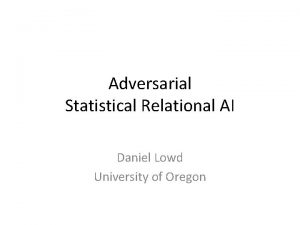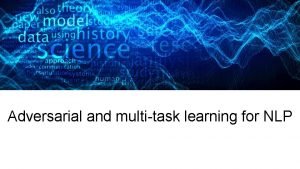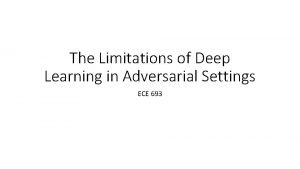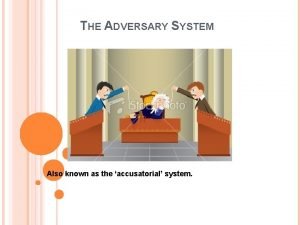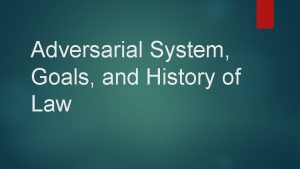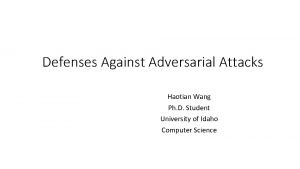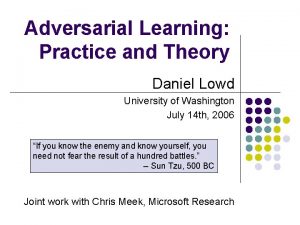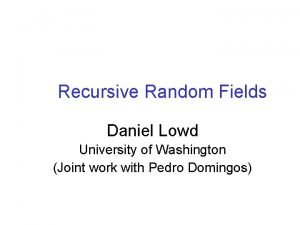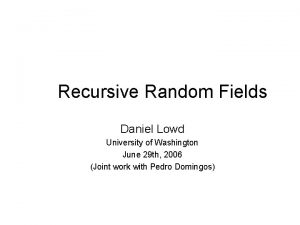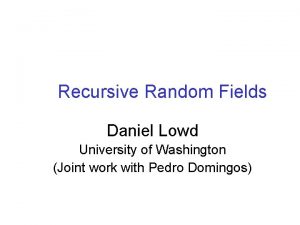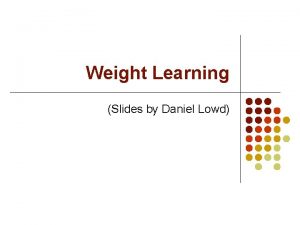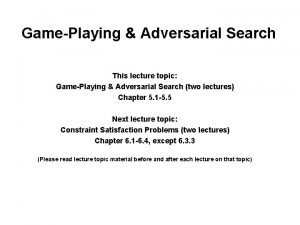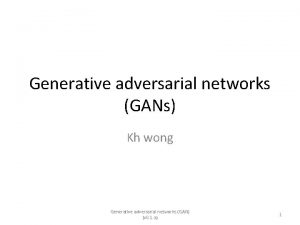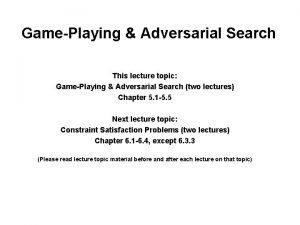Adversarial Machine Learning Daniel Lowd University of Oregon
















































- Slides: 48

Adversarial Machine Learning Daniel Lowd, University of Oregon Christopher Meek, Microsoft Research Pedro Domingos, University of Washington

Motivation n Many adversarial problems ¨ Spam filtering ¨ Malware detection ¨ Worm detection ¨ New ones every year! n n Want general-purpose solutions We can gain much insight by modeling adversarial situations mathematically

Example: Spam Filtering 1. From: spammer@example. com Cheap mortgage now!!! Feature Weights 2. 3. cheap = 1. 0 mortgage = 1. 5 Total score = 2. 5 > 1. 0 (threshold) Spam

Example: Spammers Adapt 1. From: spammer@example. com Cheap mortgage now!!! Eugene Oregon Feature Weights 2. 3. cheap = 1. 0 mortgage = 1. 5 Eugene = -1. 0 Oregon = -1. 0 Total score = 0. 5 < 1. 0 (threshold) OK

Example: Classifier Adapts 1. From: spammer@example. com Cheap mortgage now!!! Eugene Oregon Feature Weights 2. 3. cheap = 1. 5 mortgage = 2. 0 Eugene = -0. 5 Oregon = -0. 5 Total score = 2. 5 > 1. 0 (threshold) Spam OK

Outline n n Problem definitions Anticipating adversaries ¨ ¨ ¨ n n Goal: Defeat adaptive adversary Assume: Perfect information, optimal short-term strategies Results: Vastly better classifier accuracy Reverse engineering classifiers ¨ ¨ (Dalvi et al. , 2004) (Lowd & Meek, 2005 a, b) Goal: Assess classifier vulnerability Assume: Membership queries from adversary Results: Theoretical bounds, practical attacks Also: How to defeat a spam filter with 30 words or less! Conclusion

Definitions Instance space Adversarial cost function Classifier - X 2 x X 2 + X 1 X = {X 1, X 2, …, Xn} Each Xi is a feature (e. g. , a word) Instances, x X (e. g. , emails) X 1 c(x): X {+, } c C, concept class (e. g. , linear classifier) X 1 a(x): X R a A (e. g. , more legible spam is better)

Adversarial scenario - - + Adversary’s Task: Choose x to minimize a(x) subject to c(x) = + Defender’s Task: Choose new c’(x) minimize (cost-sensitive) error

Cost-sensitive error: Not all errors are equal! “Better that ten guilty persons escape than that one innocent suffer. ” -- William Blackstone, 1760 False Positive Rate (FP): Fraction of “good” instances misclassified as “bad” (e. g. , good email blocked by filter) False Negative Rate (FN): Fraction of “bad” instances misclassified as “good” (e. g. , spam that gets through) Classifier Utility: UC = 1 – c. FP FP – c. FN FN

This is a game! n n n Adversary’s actions: {x X} Defender’s actions: {c C} Assume perfect information Finding a Nash equilibrium is triply exponential (at best)! Instead, we’ll look at optimal myopic strategies: Best action assuming nothing else changes

Initial classifier Learned weights: cheap = 1. 0 mortgage = 1. 5 Eugene = -1. 0 Oregon = -1. 0 n n Set weights using cost-sensitive naïve Bayes Assume: training data is untainted

Adversary’s strategy From: spammer@ example. com Cheap mortgage now!!! Eugene Oregon cheap = 1. 0 mortgage = 1. 5 Eugene = -1. 0 Oregon = -1. 0 n n n Use cost: a(x) = Σi w(xi, bi) Solve knapsack-like problem with dynamic programming Assume: that the classifier will not modify c(x)

Classifier’s strategy Learned weights: cheap = 1. 0 mortgage = 1. 5 Eugene = -1. 0 Oregon = -1. 0 n n For given x, compute probability it was modified by adversary Assume: the adversary is using the optimal strategy

Classifier’s strategy Learned weights: cheap = 1. 5 mortgage = 2. 0 Eugene = -0. 5 Oregon = -0. 5 n n For given x, compute probability it was modified by adversary Assume: the adversary is using the optimal strategy

Evaluation: spam Good n Adversarial cost functions Plain (PL) ¨ Add Words (AW) ¨ Synonyms (SYN) ¨ Add Length (AL) ¨ n Classifier strategies NB: Naïve Bayes (baseline) ¨ AC: Adversarial Classifier ¨ n Similar results with one other dataset, or different classifier costs Bad

Repeated game: AC still wins n n Adversary responds to new classifier; classifier predicts adversary’s revised response Oscillations occur as adversaries switch strategies back and forth.

Outline n n Problem definitions Anticipating adversaries ¨ ¨ ¨ n n Goal: Defeat adaptive adversary Assume: Perfect information, optimal short-term strategies Results: Vastly better classifier accuracy Reverse engineering classifiers ¨ ¨ (Dalvi et al. , 2004) (Lowd & Meek, 2005 a, b) Goal: Assess classifier vulnerability Assume: Membership queries from adversary Results: Theoretical bounds, practical attacks Also: How to defeat a spam filter with 30 words or less! Conclusion

Imperfect information n n What can an adversary accomplish with limited knowledge of the classifier? Goals: ¨ Understand classifier’s vulnerabilities ¨ Understand our adversary’s likely strategies “If you know the enemy and know yourself, you need not fear the result of a hundred battles. ” -- Sun Tzu, 500 BC

Adversarial Classification Reverse Engineering (ACRE) - + Adversary’s Task: Minimize a(x) subject to c(x) = Problem: The adversary doesn’t know c(x)!

Adversarial Classification Reverse Engineering (ACRE) ? X 2 ? + Within a factor of k n n ? - ? ? ? X 1 Task: Minimize a(x) subject to c(x) = Given: –Full knowledge of a(x) –One positive and one negative instance, x+ and x –A polynomial number of membership queries

Comparison to other theoretical learning methods Probably Approximately Correct (PAC): accuracy over same distribution n Membership queries: exact classifier n ACRE: single low-cost, negative instance n

ACRE example Linear classifier: c(x) = +, iff (w x > T) Linear cost function: X 2 xa X 1

Linear classifiers with continuous features n n ACRE learnable within a factor of (1+ ) under linear cost functions Proof sketch Only need to change the highest weight/cost feature ¨ We can efficiently find this feature using line searches in each dimension ¨ X 2 xa X 1

Linear classifiers with Boolean features Harder problem: can’t do line searches n ACRE learnable within a factor of 2 if adversary has unit cost per change: n c(x) x- xa wi wj wk wl wm

Algorithm Iteratively reduce the cost in two ways: 1. Remove any unnecessary change: O(n) c(x) 2. xa y wi wj wk xwm wl Replace any two changes with one: O(n 3) c(x) xa y’ wi wj wk wl wp

Proof sketch (Contradiction) n Suppose there is some negative instance x with less than half the cost of y: c(x) xa wi wj wp n n n wk wl wm wr y x x’s average change is twice as good as y’s We can replace y’s two worst changes with x’s single best change But we already tried every such replacement!

Evaluation: Is O(n 3) practical? n n n Classifiers: Naïve Bayes (NB), Maxent (ME) Data: 500 k Hotmail messages, 276 k features Adversary feature sets: 23, 000 words (Dict) ¨ 1, 000 random words (Rand) ¨ Dict NB Dict ME Rand NB Cost 23 10 31 Rand ME 12 Queries 261, 000 119, 000 23, 000 Answer: Yes 9, 000

Histogram of Feature Weights “good” “spammy”

Finding features We can find good features (words) instead of good instances (emails) n Active attacks: Test emails allowed n Passive attacks: No filter access n

Active Attacks Learn which words are best by sending test messages (queries) through the filter n First-N: Find n good words using as few queries as possible n Best-N: Find the best n words n

First-N Attack Step 1: Find a “Barely spam” message Original legit. Hi, mom! “Barely legit. ” now!!! “Barely spam” mortgage now!!! Original spam Cheap mortgage now!!! Spam Legitimate Threshold

First-N Attack Step 2: Test each word Good words “Barely spam” message Spam Legitimate Less good words Threshold

Best-N Attack Spam Legitimate Better Worse Threshold Key idea: use spammy words to sort the good words.

Results: Words/queries tradeoff Attack type First-N Best-N ACRE (Rand) Naïve Bayes Maxent words (queries) 59 (3, 100) 20 (4, 300) 29 (62, 000) 9 (69, 000) 31* (23, 000) 12* (9, 000) * words added + words removed

Passive Attacks n Heuristics Select random dictionary words (Dictionary) ¨ Select most frequent English words (Freq. Word) ¨ Select highest ratio: English freq. /spam freq. (Freq. Ratio) ¨ n n Spam corpus: spamarchive. org English corpora: Reuters news articles ¨ Written English ¨ Spoken English ¨ 1992 USENET ¨

Passive Attack Results

Comparison of all attacks Attack type First-N Best-N ACRE (Rand) Passive Naïve Bayes Maxent words (queries) 59 (3, 100) 20 (4, 300) 29 (62, 000) 9 (69, 000) 31* (23, 000) 12* (9, 000) 112 (0) 149 (0) * words added + words removed

Conclusion n Mathematical modeling is a powerful tool in adversarial situations ¨ Game theory lets us make classifiers aware of and resistant to adversaries ¨ Complexity arguments let us explore the vulnerabilities of our own systems n This is only the beginning… ¨ Can we weaken our assumptions? ¨ Can we expand our scenarios?

Convex classifiers with continuous features? n n ACRE learnable under linear cost function? Proof ideas For convex spam, only need to change a single feature ¨ For convex non-spam, may need to iteratively approximate the non-spam set using cutting planes ¨ x. X 2 xa xa X 1

Conclusion n Mathematical modeling is a powerful tool in adversarial situations ¨ Game theory lets us make classifiers aware of and resistant to adversaries ¨ Complexity arguments let us explore the vulnerabilities of our own systems n This is only the beginning… ¨ Can we weaken our assumptions? ¨ Can we expand our scenarios?

Example: Trivial cost function X 2 - + X 1 n n n Suppose a small, constant number of instances have cost a(x) = b, and all others have cost a(x) = b’, where b’ > b Test each of the b-cost instances If none is negative, choose x

Example: Boolean conjunctions n n Suppose c is a conjunction of Boolean literals (e. g. , x 1 x 3) Starting with x+, toggle each xi in turn: x+ = (x 1 = T, x 2 = F, x 3 = F, x 4 = T) Guess: (x 1 x 2 x 3 x 4)

Example: Boolean conjunctions n n Suppose c is a conjunction of Boolean literals (e. g. , x 1 x 3) Starting with x+, toggle each xi in turn: x+ = (T, F, F, T) Guess: (x 1 x 2 x 3 x 4)

Example: Boolean conjunctions n n Suppose c is a conjunction of Boolean literals (e. g. , x 1 x 3) Starting with x+, toggle each xi in turn: x+ = (T, F, F, T) x’ = (F, F, F, T) c(x’) = Guess: (x 1 x 2 x 3 x 4)

Example: Boolean conjunctions n n Suppose c is a conjunction of Boolean literals (e. g. , x 1 x 3) Starting with x+, toggle each xi in turn: x+ = (T, F, F, T) x’ = (T, T, F, T) c(x’) = + Guess: (x 1 x 2 x 3 x 4)

Example: Boolean conjunctions n n Suppose c is a conjunction of Boolean literals (e. g. , x 1 x 3) Starting with x+, toggle each xi in turn: x+ = (T, F, F, T) x’ = (T, F, T, T) c(x’) = Guess: (x 1 x 2 x 3 x 4)

Example: Boolean conjunctions n n Suppose c is a conjunction of Boolean literals (e. g. , x 1 x 3) Starting with x+, toggle each xi in turn: x+ = (T, F, F, T) x’ = (T, F, F, F) c(x’) = Guess: (x 1 x 2 x 3 x 4) Final Answer: (x 1 x 3)

Example: Boolean conjunctions n n n Suppose c is a conjunction of Boolean literals (e. g. , x 1 x 3) Starting with x+, toggle each xi in turn Exact conjunction is learnable in n queries. Now we can optimize any cost function. In general: concepts learnable with membership queries are ACRE 1 -learnable
 Daniel lowd
Daniel lowd Daniel lowd
Daniel lowd Moral judgement definition
Moral judgement definition Quantum generative adversarial learning
Quantum generative adversarial learning Adversarial multi-task learning for text classification
Adversarial multi-task learning for text classification The limitations of deep learning in adversarial settings.
The limitations of deep learning in adversarial settings. Concept learning task in machine learning
Concept learning task in machine learning Analytical learning in machine learning
Analytical learning in machine learning Pac learning model in machine learning
Pac learning model in machine learning Pac learning model in machine learning
Pac learning model in machine learning Inductive and analytical learning in machine learning
Inductive and analytical learning in machine learning Analytical learning vs inductive learning
Analytical learning vs inductive learning Instance based learning in machine learning
Instance based learning in machine learning Inductive learning machine learning
Inductive learning machine learning First order rule learning in machine learning
First order rule learning in machine learning Eager learning examples
Eager learning examples Cmu machine learning
Cmu machine learning Oregon state wue
Oregon state wue University of oregon student jobs
University of oregon student jobs Phi delta theta university of oregon
Phi delta theta university of oregon Oregon state university accounting
Oregon state university accounting Southern oregon university human resources
Southern oregon university human resources Arotc oregonstate
Arotc oregonstate Ois operating system
Ois operating system Mybill oregon state
Mybill oregon state Oregon early learning and kindergarten guidelines
Oregon early learning and kindergarten guidelines Cuadro comparativo de e-learning
Cuadro comparativo de e-learning Adversarial stakeholders
Adversarial stakeholders Adversarial trial system
Adversarial trial system Definition of adversary system
Definition of adversary system Sigir 2018
Sigir 2018 Friendly adversarial training
Friendly adversarial training On adaptive attacks to adversarial example defenses
On adaptive attacks to adversarial example defenses Adversarial interview
Adversarial interview Adversarial system law definition
Adversarial system law definition Adversarial search problems uses
Adversarial search problems uses Adversarial examples
Adversarial examples Generative adversarial network
Generative adversarial network Spectral normalization for generative adversarial networks
Spectral normalization for generative adversarial networks Conditional generator
Conditional generator Adversarial training
Adversarial training Adversarial training
Adversarial training Certified defenses against adversarial examples
Certified defenses against adversarial examples Adversarial patch
Adversarial patch Generative adversarial networks
Generative adversarial networks Daniel cohan rice university
Daniel cohan rice university Finite state machine vending machine example
Finite state machine vending machine example Moore machine
Moore machine Mealy to moore conversion
Mealy to moore conversion

